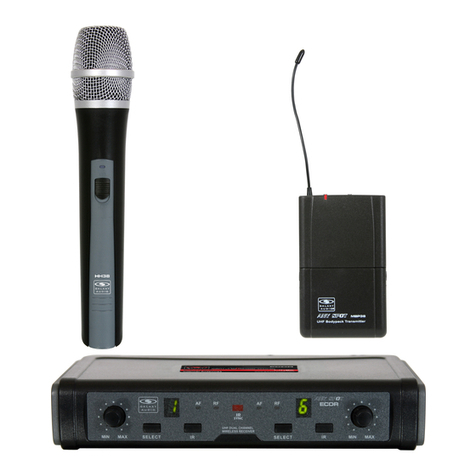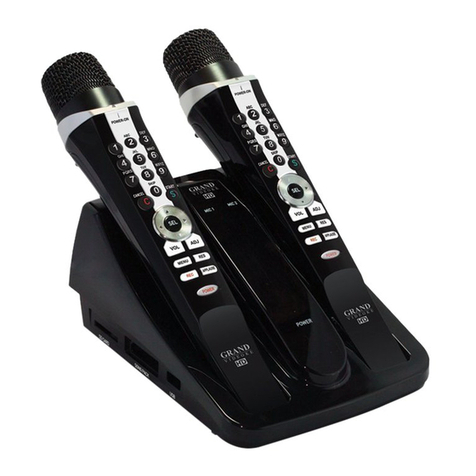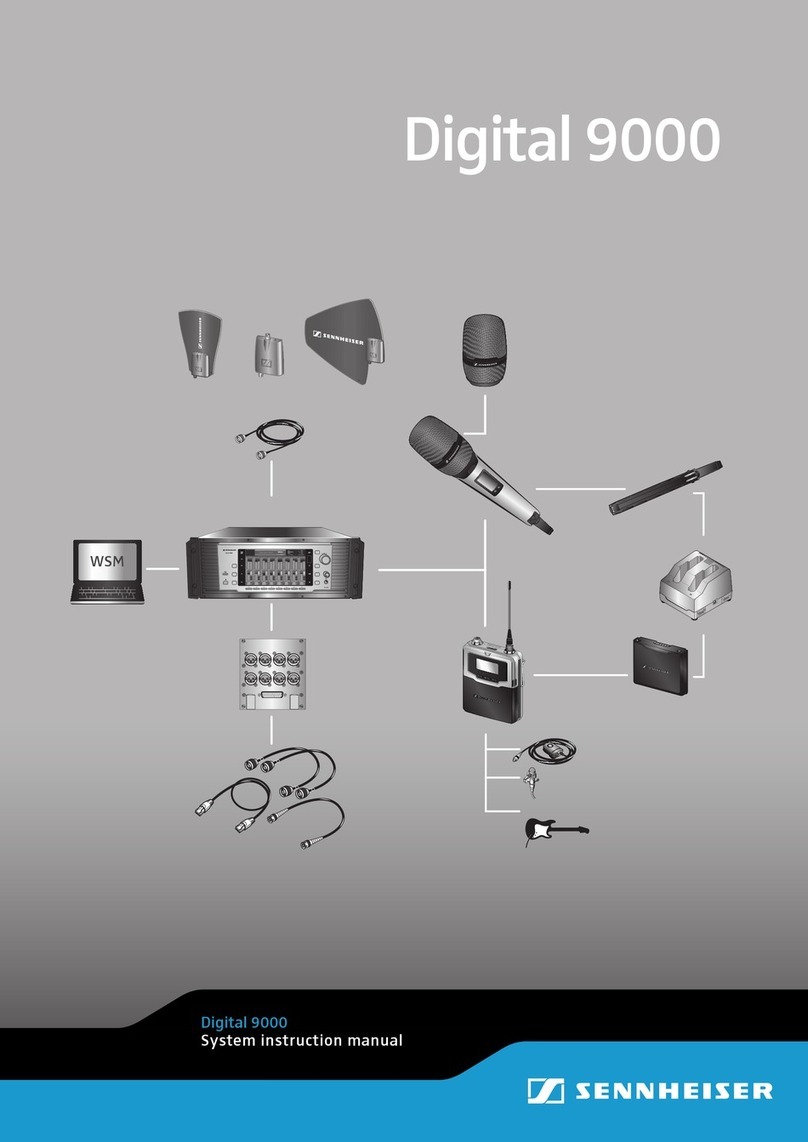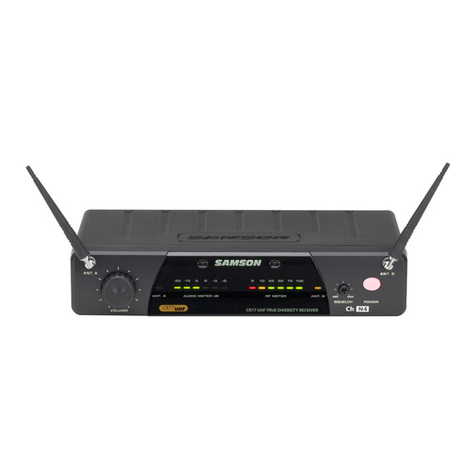the t.bone free2b User manual

Thomann GmbH • Hans-Thomann-Straße 1 • 96138 Burgebrach • www.thomann.de • [email protected] DocID: 450914_25.05.2022
EN
free2b | wireless transmission system
Quick Start Guide
This quick start guide contains important information on the safe operation of the
product. Read and follow the safety advice and instructions given. Retain the quick
start guide for future reference. If you pass the product on to others please include
this quick start guide.
Features
• Attachment system for dynamic microphones
• Ready-to-use set of transmitter and receiver, auto-pairing
• 2.4 GHz band suitable for worldwide license-free operation
• 24bit / 44.1kHz high-denition audio quality
• Built-in lithium-ion rechargeable battery
• Charging via supplied micro USB cable
• LED indicators for charge status and current channel group
• Adapter from XLR to 3.5mm mini jack included
Operating elements
Transmitter
1. XLR connector socket
2. Channel indicator
3. On/o button
4. RF status LED ring
5. Micro-USB port
6. XLR socket lock
Receiver
1. XLR connector plug
2. Channel indicator
3. On/o button
4. RF status LED ring
5. Micro-USB port
For the transport and protective packaging, environmentally friendly materials have
been chosen that can be supplied to normal recycling. Ensure that plastic bags, packag-
ing, etc. are properly disposed of. Do not just dispose of these materials with your nor-
mal household waste, but make sure that they are collected for recycling. Please follow the notes
and markings on the packaging.
Remove replaceable lithium batteries from the device before disposal. Protect used lith-
ium batteries from short circuits, for example by covering the poles with adhesive tape.
Permanently installed lithium batteries must be disposed of together with the device. Please in-
quire about a suitable acceptance point.
This product is subject to the European Waste Electrical and Electronic Equipment Direc-
tive (WEEE) in its currently valid version. Do not dispose of your old device with your
normal household waste. Dispose of this product through an approved waste disposal
rm or through your local waste facility. Comply with the rules and regulations that apply
in your country. If in doubt, consult your local waste disposal facility.
Safety instructions
Intended use
This device is meant to be used for wireless transmission of audio signals with micro-
phone level. Any other use or use under other operating conditions is considered to
be improper and may result in personal injury or property damage. No liability will be
assumed for damages resulting from improper use.
Danger for children
Ensure that plastic bags, packaging, etc. are disposed of properly and are
not within reach of babies and young children. Choking hazard! Ensure
that children do not detach any small parts (e.g. knobs or the like) from the
unit. They could swallow the pieces and choke! Never let unattended chil-
dren use electrical devices.
Electromagnetic compatibility with other electrical equipment
Using the device near radios or TV sets may cause interference. Then increase the
distance between the devices.
Incorrect handling of lithium batteries can result in injury
• In the event of a short circuit, overheating or mechanical damage, lithium batter-
ies can cause severe injuries.
• When handled correctly and appropriately lithium batteries pose no risk.
• Store lithium batteries in a cool, dry place, ideally in the original packaging.
• Store lithium batteries away from heat sources (e.g. radiators or sunlight). Lithium
batteries are hermetically sealed. Never attempt to open a lithium battery.
• If the battery housing is damaged small amounts of the electrolyte may leak out. If
this should happen, seal the lithium battery in airtight packaging and wipe up the
traces of electrolyte using absorbent paper towels. You must wear protective rub-
ber gloves when doing so. Clean your hands and the aected surface thoroughly
with cold water.
• Never attempt to recharge non-rechargeable lithium batteries. When charg-
ing lithium batteries you must use a suitable charging device intended for the
purpose.
• Before disposing of the device remove the lithium batteries. Protect used lithium
batteries against potential short circuits, e.g. by covering the poles with adhesive
tape.
• Only use powder extinguishers or other suitable extinguishing agents to extinguish
a burning lithium battery.
Possible damage due to incorrect storage
• Deep discharge can cause batteries to become permanently damaged or lose some
of their capacity.
• Before prolonged rest periods, charge the batteries to around 50% of their capacity
and then switch the equipment o. Store the equipment at a temperature between
10°C and 32°C in as dry an environment as possible. During extended storage peri-
ods, charge the batteries to 50% approximately every three months.
• Only fully charge the batteries at room temperature just before use.
Where to use the product
Never use the product
• in direct sunlight
• in conditions of extreme temperature or humidity
• in extremely dusty or dirty areas
• at locations where the unit can become wet
• near magnetic elds
General handling
• To prevent damage, never use force when operating the switches and controls.
• Never immerse the appliance in water. Just wipe it with a clean dry cloth. Do not use
liquid cleaners such as benzene, thinners or ammable cleaning agents.
Keep foreign substances from the unit!
Keep the device away from containers with liquids. Should any liquid get into the unit,
this could lead to its destruction or re. Be sure not to let any metal objects into the unit.

Thomann GmbH • Hans-Thomann-Straße 1 • 96138 Burgebrach • www.thomann.de • [email protected] DocID: 450914_25.05.2022
Technical specications
Receiver
Max. number of parallel systems 6 systems
Output connections 1×XLR male
Output level adjustment ./.
Frequency of operation 2.404–2.439GHz
Bandwidth Wireless transmission 2.55MHz
Audio 20–20kHz
Sensitivity -90dBm
Antenna gain 2.85dBi
Total harmonic distortion (THD) 0.05%
Signal-to-noise ratio >110dB(A)
Latency <3.5ms
Battery Battery type Lithium-ion
Voltage 3.7V
Capacity 700mAh
Operating time 7h
Charging time 3h
Dimensions (W × H × D) approx. 108mm×26mm×26mm
Weight 130g
Ambient conditions Temperature range 0 °C…40 °C
Relative humidity 20 %…80 % (non-condensing)
Transmitter
Input connections 1×XLR female
Frequency of operation 2.404–2.439GHz
Max. transmission power 10mW
Input level max. +6dBV
Bandwidth Wireless transmission 2.55MHz
Audio 20–20kHz
Input impedance 4kΩ
Range (free eld) 30m
Total harmonic distortion (THD) 0.05 % | THD+N <0,2%
Signal-to-noise ratio >110dB(A)
Battery Battery type Lithium-ion
Voltage 3.7V
Capacity 700mAh
Operating time 7h
Charging time 3h
Dimensions (W × H × D) approx. 108mm×26mm×26mm
Weight 130g
Ambient conditions Temperature range 0 °C…40 °C
Relative humidity 20 %…80 % (non-condensing)
Using the device
Switching on / o
1. To turn on the devices, press their on/o buttons e. Channel indicators wwill
now work as a charge indicator for one second:
If the charge state drops below approx. 10%, the RF status LED ring rashes red
twice and the device shuts o automatically.
2. To charge the built-in battery, connect the micro-USB jack t. Use the supplied
USB cable with a powered-on computer or other USB charging source. During
charging, the RF status LED ring rlights red. When charging has nished, the RF
status LED ring rlights up blue. If the devices are not in use for a long time, fully
charge the batteries every three months.
Connecting and pairing devices
1. Plug the XLR socket of the transmitter into the XLR connector of the microphone.
Plug the XLR plug of the receiver into the XLR input of a mixer or similar device
for further signal processing (see the gure on the right).
2. After switching on both devices, they perform an automatic pairing and select
a suitable channel group. Wait until the RF status LED ring rof the transmitter
lights up blue. The pairing is now complete and the devices display the currently
used channel group.
To avoid interference, keep the devices at least 3 meters away from other trans-
mission equipment such as WiFi routers, etc.
Microphone
Receiver
Mixer
Transmitter
Auto Standby
1. If the transmitter is not connected to a microphone 30 seconds after power is
turned on, or if the input signal remains o for 30 seconds, the transmitter and
the paired receiver automatically switch to standby mode to conserve battery
power. When the signal returns, both devices switch on again immediately.
2. If the transmitter is not connected to a micro-
phone for 1 hour after power is turned on, or
if the input signal remains o for 1 hour, both
devices will switch o completely. To turn them
back on, press the on/o button eof both units.
free2b | wireless transmission system
EN
Popular Microphone System manuals by other brands
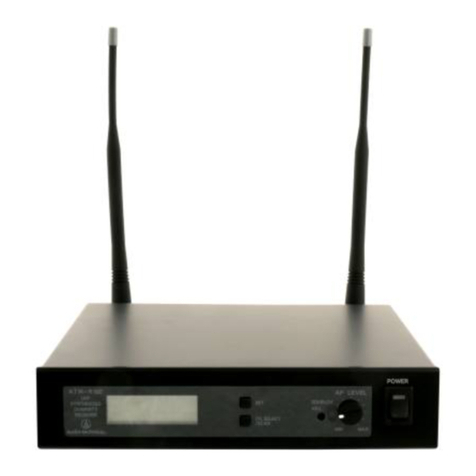
Audio Technica
Audio Technica UniPak ATW-1661 Installation and operation

Simeon
Simeon Ranger user manual
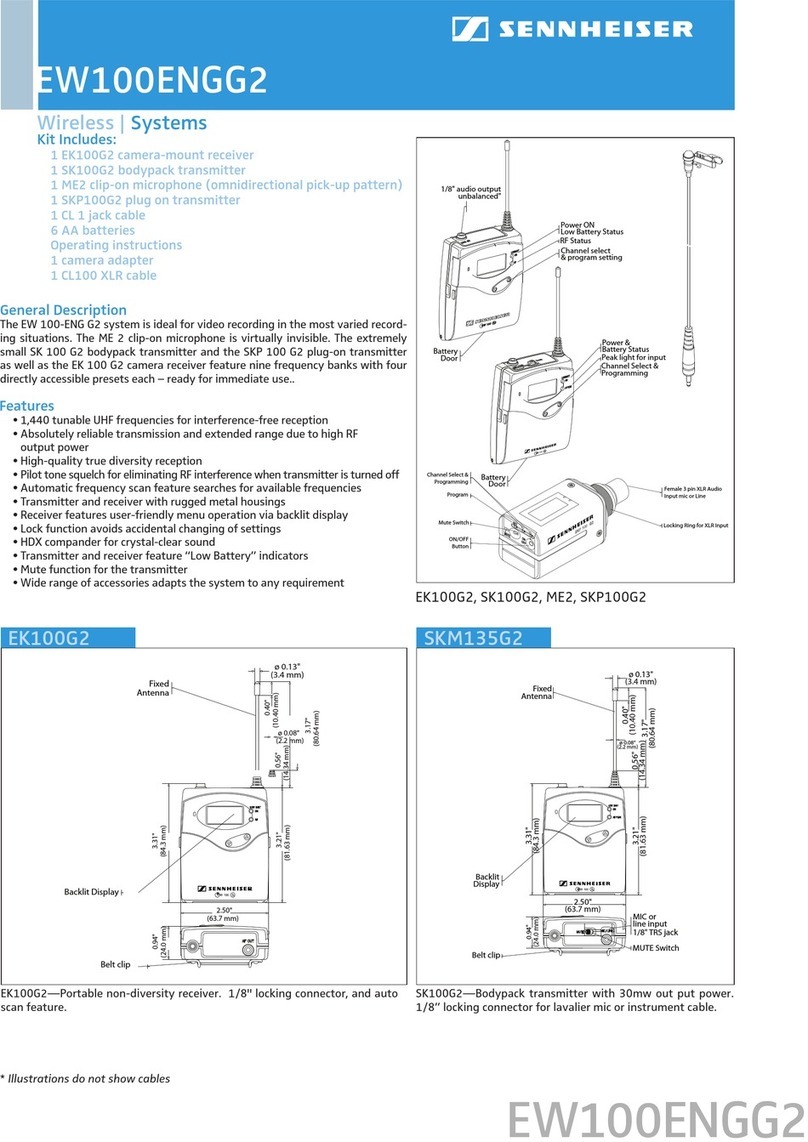
Sennheiser
Sennheiser EW 100 G2 operating instructions
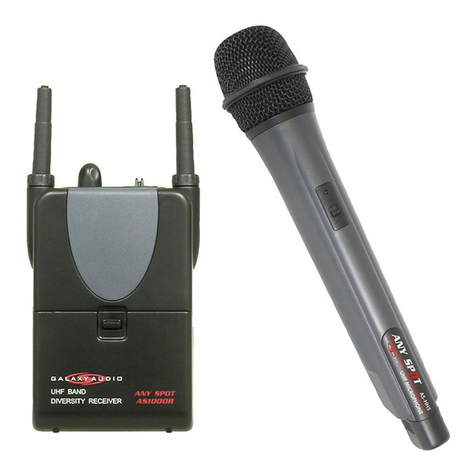
Galaxy Audio
Galaxy Audio ANY SPOT AS-HH5CK user manual
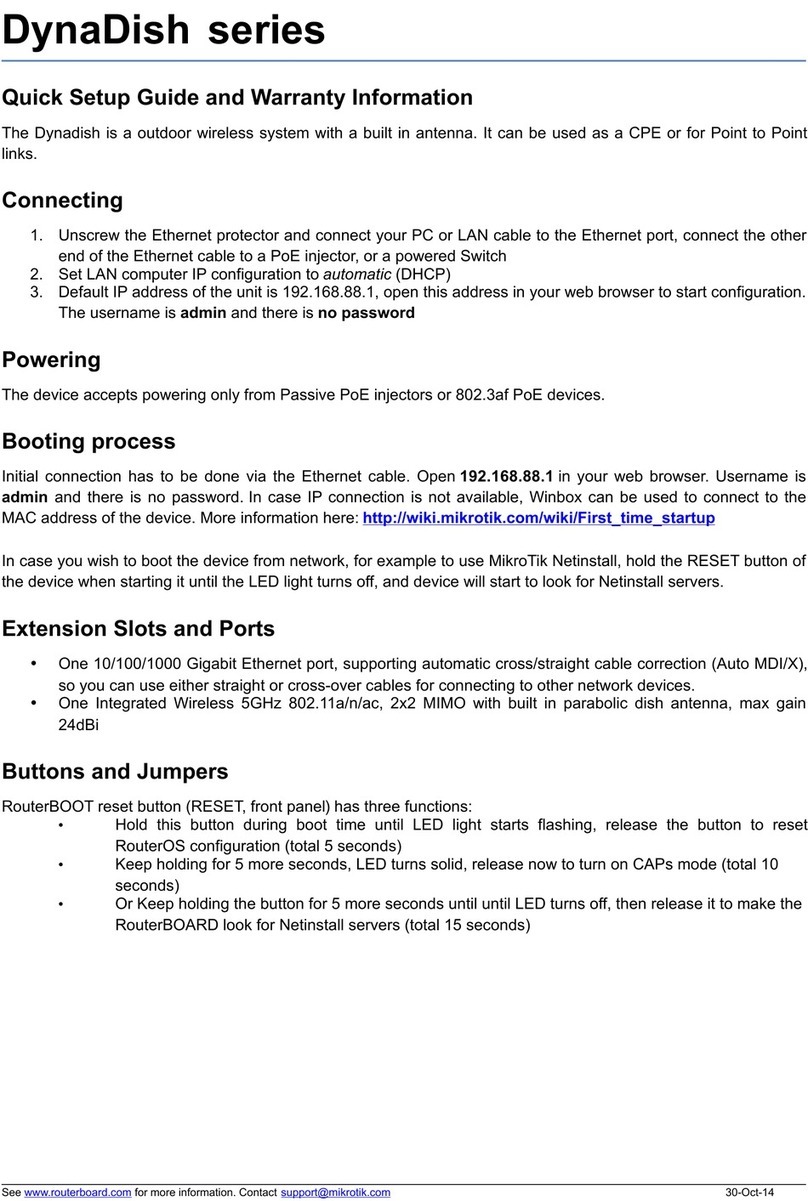
MikroTik
MikroTik Dynadish Series Quick setup guide and warranty information

Eikon
Eikon J&M user manual

Earthworks
Earthworks DP25C user manual
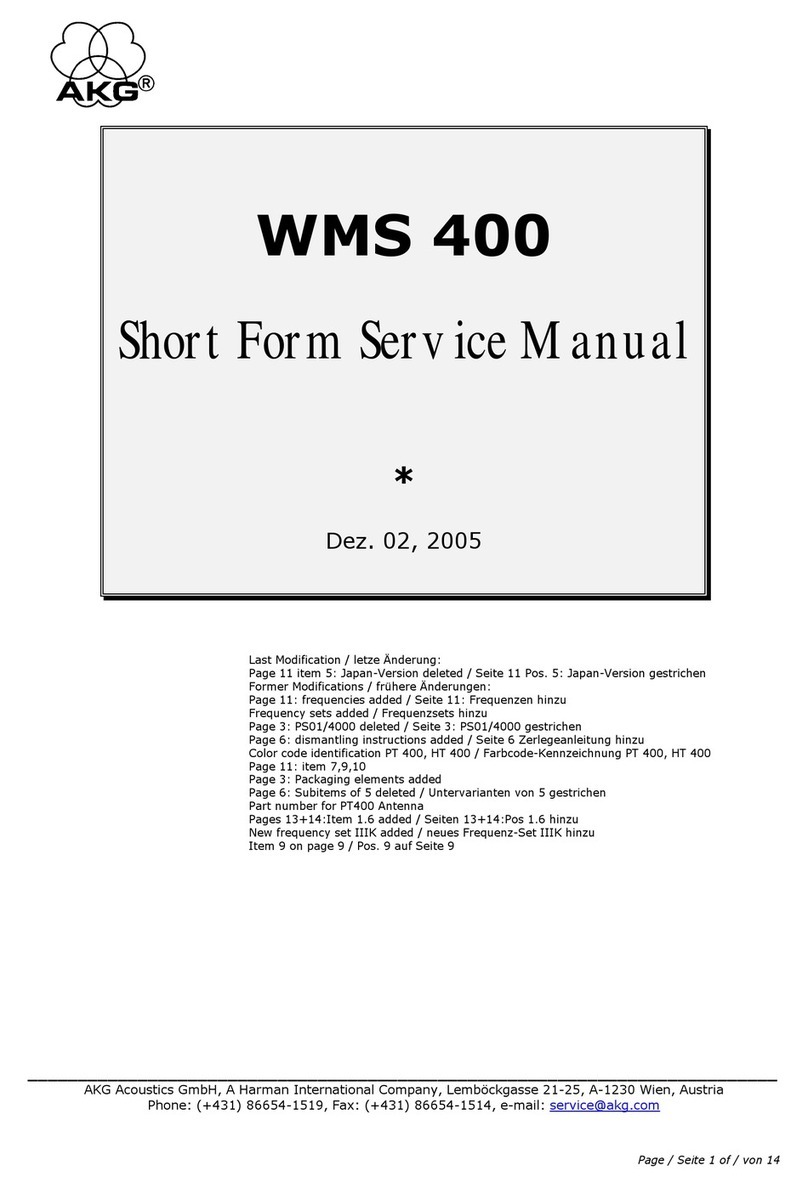
AKG
AKG WMS 400 Short form service manual

Taisync
Taisync ViULinx Lite user manual

Audio Technica
Audio Technica Artist Elite AEW-DA550C Installation and operation
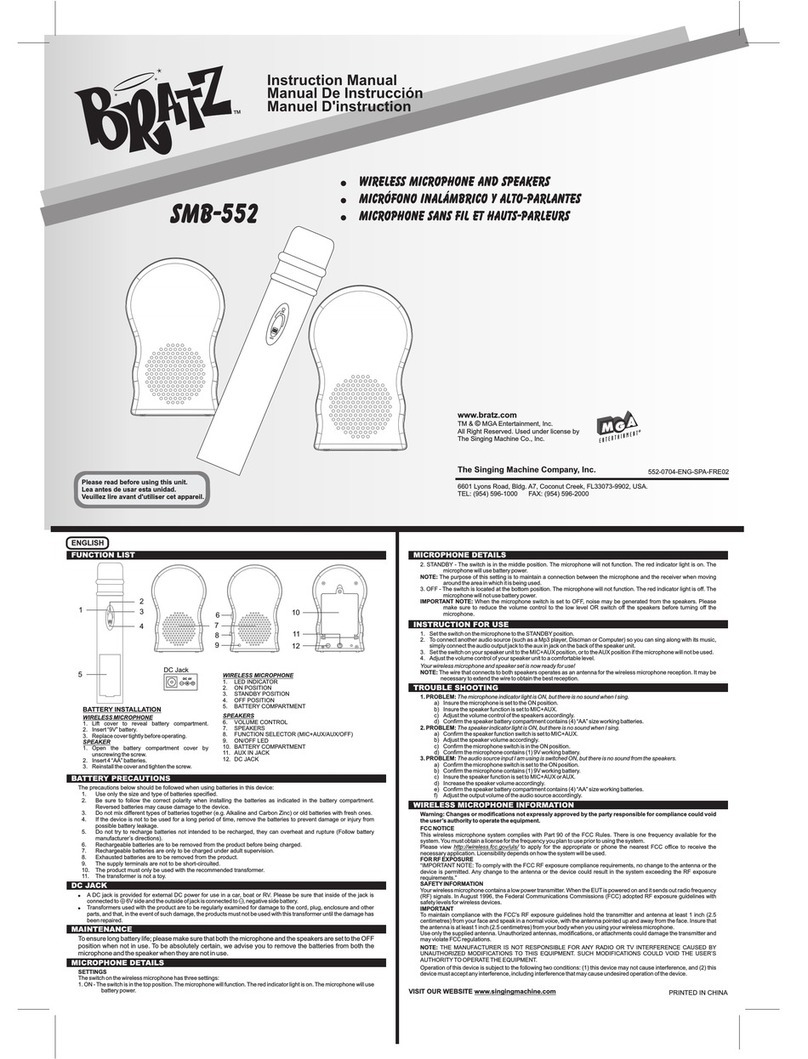
The Singing Machine
The Singing Machine Bratz SMB-552 instruction manual

Eaton
Eaton EEV-7202 Service manual
